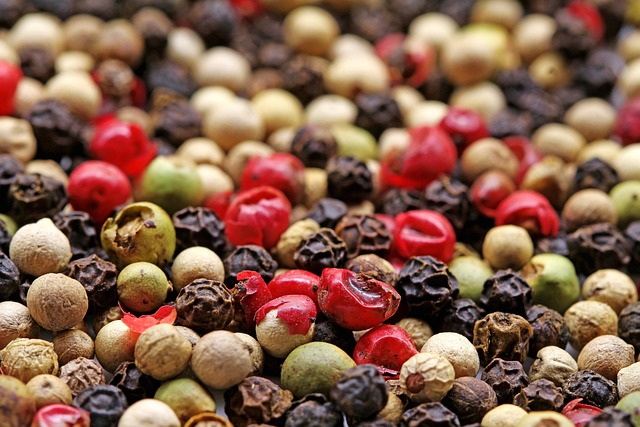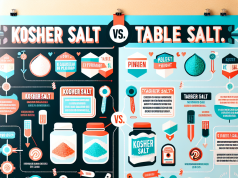Contents
White Pepper: The Secret Ingredient in Many Asian Dishes
White pepper is a widely used spice in Asian cuisine, known for its unique flavor and aroma. It is derived from the same plant as black pepper, Piper nigrum, but is processed and harvested differently to achieve its distinct taste.
Keywords: white pepper, Asian dishes, spice, flavor, aroma, Piper nigrum, black pepper
White pepper is created by removing the outer skin or pericarp of the peppercorns, leaving behind the inner seed. This process involves soaking the peppercorns in water until the skin loosens, which is then removed through various methods such as rubbing, scrubbing, or mechanical separation.
The resulting white pepper has a milder and less pungent flavor compared to black pepper. It is often described as being earthy and slightly fermented, with hints of floral and citrus notes. Due to its subtle taste, white pepper is frequently used in dishes where its flavor can shine through without overpowering other ingredients.
In many Asian countries, white pepper is a staple seasoning in both savory and spicy dishes. It is widely used in soups, stir-fries, marinades, and sauces. The versatility of white pepper makes it an essential ingredient in popular Asian culinary traditions such as Chinese, Thai, Vietnamese, and Indonesian cuisines.
Not only does white pepper add a delicious flavor to Asian dishes, but it also offers various health benefits. It contains a compound called piperine, which has been linked to potential antioxidant and anti-inflammatory properties. Additionally, white pepper is believed to aid digestion, stimulate appetite, and improve overall gastrointestinal health.
Next time you enjoy your favorite Asian dish, take a moment to appreciate the subtle yet powerful contribution of white pepper. Its understated presence adds depth and complexity to the flavors, making it truly an indispensable secret ingredient.
The Versatility of White Pepper
When it comes to cooking Asian cuisine, white pepper is an essential spice that can elevate the flavor of dishes from bland to exciting and delicious. While black pepper is commonly used in Western cooking, white pepper holds a special place in many Asian kitchens. In this blog post, we will explore the secret behind this humble ingredient and its many uses in Asian cuisine.
What is White Pepper?
White pepper comes from the Piper nigrum plant, just like black pepper. However, the difference lies in the way they are processed. White pepper is made from fully ripe pepper berries that are soaked in water, allowing the outer skin to be removed. The remaining seed is then dried, resulting in white or cream-colored pepper.
Key Characteristics of White Pepper
One of the key characteristics of white pepper is its distinct aroma and flavor. Compared to black pepper, it has a slightly milder and more complex taste. White pepper also tends to blend seamlessly into dishes, making it highly versatile in cooking. This spice is commonly used in both whole and powdered forms, depending on the recipe requirements.
Common Uses in Asian Cuisine
White pepper is widely used in various Asian dishes, adding depth and spice to a multitude of recipes. It is a staple in Chinese, Thai, Vietnamese, and Malaysian cuisines, among others. The spice is often used in soups, stir-fries, marinades, and sauces to enhance the overall flavor profile.
Benefits of Using White Pepper
Aside from its ability to enhance flavors, white pepper also offers several health benefits. It can aid in digestion, promote intestinal health, and act as a natural antioxidant due to its rich content of vitamins and minerals.
Pairing Recommendations
White pepper pairs well with a wide range of ingredients. It complements meats like chicken, pork, and seafood, as well as vegetables such as cabbage, mushrooms, and bell peppers. The spice also works wonders in combination with garlic, ginger, soy sauce, and other traditional Asian condiments.
Where to Buy White Pepper?
White pepper is readily available in most grocery stores, spice markets, and online retailers. When purchasing, opt for whole peppercorns and grind them as needed to maintain maximum freshness and flavor. Store them in a cool and dry place to preserve their quality over time.
Discover Exciting White Pepper Recipes
If you want to explore the world of Asian cuisine and experiment with white pepper, check out our blog post on exciting recipes using this versatile spice. From classic stir-fries to comforting soups, you’ll find endless inspiration to incorporate white pepper into your cooking.
Why is white pepper commonly used in Asian cuisine?
White pepper is a key ingredient in many Asian dishes because it has a distinct flavor and aroma that complements various spices used in this cuisine. Its mild heat and earthy undertones enhance the overall taste profile.
How is white pepper different from black pepper?
White pepper comes from the same plant as black pepper, but it undergoes a different processing method. The outer layer, known as the pericarp, is removed from the seed, leaving a white-colored pepper with a slightly different flavor profile compared to black pepper.
Where can I use white pepper in cooking?
White pepper is versatile and can be used in a wide range of dishes. It is commonly used in stir-fries, soups, marinades, and sauces. It pairs well with seafood, poultry, vegetables, and tofu, adding a unique depth of flavor.
Does white pepper have any health benefits?
White pepper, like black pepper, contains beneficial compounds such as piperine, which may have antioxidant and anti-inflammatory properties. It also aids digestion and can help stimulate appetite in certain individuals.
Can I substitute white pepper with black pepper?
While white pepper and black pepper come from the same plant, they have different flavors. Substituting white pepper with black pepper may alter the taste and appearance of the dish. However, in certain recipes, a small amount of black pepper can be used as a substitute if white pepper is not available.
Benefits of White Pepper in Culinary Delights
Enhancing Flavor with White Pepper
White pepper, which consists of the seed of the pepper plant, is a versatile spice widely used in culinary preparations around the world. Due to its distinct flavor profile and various health benefits, white pepper has become a staple ingredient in many recipes.
White Pepper in Traditional Asian Cuisine
In traditional Asian cuisine, white pepper is known for its ability to add a subtle heat and depth of flavor to dishes. It is a key ingredient in popular dishes such as hot and sour soup, stir-fries, and marinades. The spiciness of white pepper is milder compared to its black counterpart, making it a preferred choice in those cuisines where a gentler, less pungent flavor is desired.
The Role of White Pepper in Western Cooking
White pepper also plays a crucial role in Western cooking, particularly in creamy soups, sauces, and mashed potatoes. Its fine texture allows it to blend seamlessly with these preparations, providing a subtle spicy kick without altering the appearance of the final dish.
Health Benefits Linked to White Pepper
Beyond its culinary applications, white pepper offers several potential health benefits. It contains piperine, a compound that may aid digestion, promote healthy gut bacteria, and possess anti-inflammatory properties. Additionally, white pepper is rich in antioxidants that can help protect against cellular damage.
If you want to learn more about white pepper, feel free to visit the White Pepper page on Wikipedia.
-
White Pepper
-
Key Information
- Secret ingredient in many Asian dishes








































